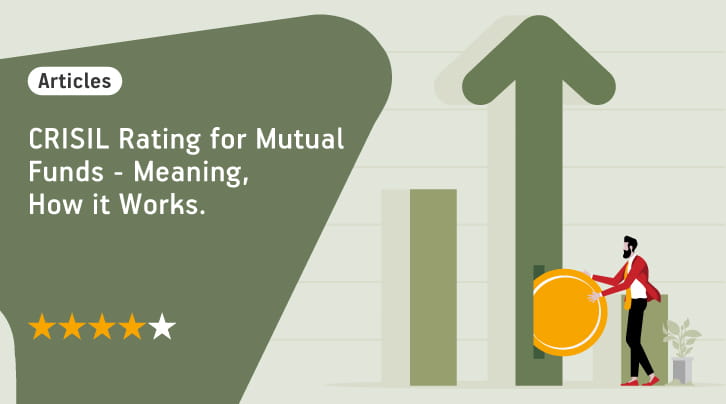The CRISIL rating system can be a valuable tool for investors to evaluate various mutual fund schemes. Read this post to learn more about this rating system and invest prudently.
While numerous mutual fund schemes are available in India, selecting the right one can be challenging. In such a scenario, the CRISIL rating for mutual funds can come to the rescue of investors.
This post will discuss the CRISIL rating for mutual funds in detail. We will also discuss the parameters on which CRISIL ranks mutual funds, how it can help investors, and other relevant information.
Let’s get started.
What Is Crisil Rating for Mutual Funds?
The Credit Rating Information Service of India Limited (CRISIL) is a globally known credit rating agency in India. It evaluates and ranks mutual funds in India based on various parameters discussed later in the article. Additionally, CRISIL provides a wide range of services, such as consulting, data & analytics, fundamental research, etc.
The CRISIL Mutual Fund Ranking, or CMFR, was launched in June 2000. It evaluates the performance and risk of various mutual fund schemes in India across various asset classes like equity, debt, and hybrid.
Its mutual fund rankings are based on Net Asset Value (NAV) and portfolio-based characteristics. This is one of the reasons why investors and fund houses acknowledge CMFR data.
Parameters on Which Crisil Ranks Mutual Funds
CRISIL uses a comprehensive methodology to evaluate mutual fund schemes. Following are the parameters on which CRISIL ranks mutual funds.
Superior Return Score (SRS)
SRS compares a mutual fund's returns and risks to other similar portfolios. For instance, you can only compare a large-cap fund’s returns and risks with another large-cap fund.
Industry Risk Score
CRISIL considers industry risks when evaluating debt funds and assigns an Industry Risk Score (IRS) to the fund. The IRS assesses the ability of companies to repay their debts within a specific time frame.
Mean Return & Volatility
Mean return refers to the average daily return earned by a mutual fund over a specific period. It is calculated based on the fund's NAV. Volatility, on the other hand, is the amount of variation in returns.
Portfolio Concentration Analysis
Too much diversification can be risky in mutual fund investments. This is because over-diversification can lead to a fund ending up with similar stocks. This can defeat the purpose of diversification and can increases the concentration risk. Therefore, a portfolio having too much diversification will be ranked low in this analysis.
Liquidity Analysis
It is used to evaluate how easily a mutual fund house can sell off its holdings and convert them into cash. A lower liquidity score suggests that the fund has a higher level of liquidity, meaning it can be easily redeemed or traded.
Quality of Asset
It is a measure of the creditworthiness of the issuer and the overall risk associated with investing in debt security. Simply put, asset quality evaluates the likelihood of the debt security issuer defaulting on timely debt repayment.
Tracking Error
It measures how the index fund tracks its benchmark index. A low tracking error is considered a good sign as it indicates that the index fund is more precisely tracking its benchmark.
Counting of Negative Returns
This metric is majorly used for arbitrage funds to measure their downside risks.
How Does the CRISIL Mutual Fund Ranking Help Investors?
CRISIL mutual fund ranking provides a quick and easy way for investors to compare different mutual fund schemes and select the one that suits their investment objectives and risk appetite. Apart from investors, financial advisors and mutual fund analysts also follow these ratings to recommend the right fund to an investor.
Ranking of Mutual Funds by CRISIL - The Process
CRISIL assigns ranks to mutual funds based on its analysis. Rank 1 is the topmost rank for the top 10 percentile, followed by rank 2 of the next 20 percentile, and so on.
Moreover, CRISIL rates mutual funds based on their performance over different time frames, such as three years, five years, or ten years. After assigning ratings, the agency assigns stars to the funds based on their respective percentiles. Funds in the top 10% receive a 5-star rating, while those in the bottom 10% receive a 1-star rating.
Source - https://www.crisil.com/content/dam/crisil/generic-images1/what-we-do/financial-products/mutual-fund-ranking/CRISIL_Mutual_Fund_Ranking_Methodology.pdf
Use CRISIL Ratings to Your Advantage
A mutual fund’s CRISIL ranking can provide a good insight into its performance over a certain period. Therefore, CRISIL ratings can be a good research tool for mutual fund investors to spot well-performing funds.
However, the CRISIL rating should not be the only factor while making investment decisions. Investors should do their due diligence and consider other factors like investment goals, risk appetite, and portfolio diversification before investing in mutual funds.
Mutual Fund investments are subject to market risks, read all scheme related documents carefully.





 1800-270-7000
1800-270-7000




